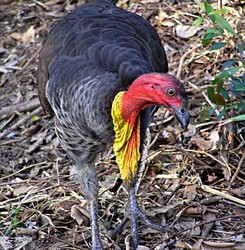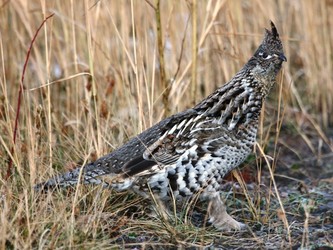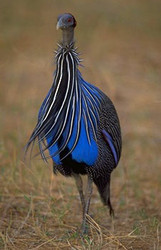Galliformes
Fowl, Quail, Guans, Currasows, Megapodes



This tree diagram shows the relationships between several groups of organisms.
The root of the current tree connects the organisms featured in this tree to their containing group and the rest of the Tree of Life. The basal branching point in the tree represents the ancestor of the other groups in the tree. This ancestor diversified over time into several descendent subgroups, which are represented as internal nodes and terminal taxa to the right.

You can click on the root to travel down the Tree of Life all the way to the root of all Life, and you can click on the names of descendent subgroups to travel up the Tree of Life all the way to individual species.
For more information on ToL tree formatting, please see Interpreting the Tree or Classification. To learn more about phylogenetic trees, please visit our Phylogenetic Biology pages.
close boxReferences
Cox, W. A., R. T. Kimball, and E. L. Braun. 2007. Phylogenetic position on the New World quail (Odontophoridae): eight nuclear loci and three mitochondrial regions contradict morphology and the Sibley-Ahlquist tapestry. Auk 124(1):71–84.
Crowe, T. M., R. C. K. Bowie, P. Bloomer, T. G. Mandiwana, T. A. J. Hedderson, E. Randi, S. L. Pereira, and J. Wakeling. 2006. Phylogenetics, biogeography and classification of, and character evolution in, gamebirds (Aves: Galliformes): effects of character exclusion, data partitioning and missing data. Cladistics 22(6):495–532.
Dimcheff, D. E., S. V. Drovetski, M. Krishnan, and D. P. Mindell. 2000. Cospeciation and horizontal transmission of avian sarcoma and leukosis virus gag genes in galliform birds. J. Virology 74:3984-3995.
Dimcheff, D. D., S. V. Drovetski, and D. P. Mindell. 2002. Molecular evolution and systematics of tetraoninae and other Galliformes using mitochondrial 12S and ND2 genes. Molecular Phylogenetics and Evolution 24: 203-215.
Dyke, G. J., B. E. Gulas, and T. M. Crowe. 2003. The suprageneric relationships of galliform birds (Aves, Galliformes): a cladistic analysis of morphological characters. Zool. J. Linn. Soc. 137:227-244.
Kaiser, V. B., M. van Tuinen, and H. Ellegren. 2007. Insertion events of CR1 retrotransposable elements elucidate the phylogenetic branching order in galliform birds. Molecular Biology and Evolution 24(1):338-347.
Pereira, S. L. and A. J. Baker. 2006. A molecular timescale for galliform birds accounting for uncertainty in time estimates and heterogeneity of rates of DNA substitutions across lineages and sites. Molecular Phylogenetics and Evolution 38(2):499-509.
van Tuinen M, Dyke GJ. 2004. Calibration of galliform molecular clocks using multiple fossils and genetic partitions. Mol. Phylogenet. Evol. 30:74-86.
Title Illustrations

| Scientific Name | Alectura lathami |
|---|---|
| Location | Kalinga Park, Brisbane, Queensland, Australia |
| Specimen Condition | Live Specimen |
| Source | 96 Australian Brush-turkey |
| Source Collection | Flickr |
| Image Use |
 This media file is licensed under the Creative Commons Attribution-NonCommercial-NoDerivs License - Version 2.0. This media file is licensed under the Creative Commons Attribution-NonCommercial-NoDerivs License - Version 2.0.
|
| Copyright | © 2006 Jenny |
| Scientific Name | Bonasa umbellus |
|---|---|
| Specimen Condition | Live Specimen |
| Source | Ruffed Grouse 1_1979 |
| Source Collection | Flickr |
| Image Use |
 This media file is licensed under the Creative Commons Attribution-NonCommercial-NoDerivs License - Version 2.0. This media file is licensed under the Creative Commons Attribution-NonCommercial-NoDerivs License - Version 2.0.
|
| Copyright | © 2005 Jean-Guy |
| Scientific Name | Acryllium vulturinum |
|---|---|
| Location | Samburu National Reserve (Kenya) |
| Comments | Vulturine Guineafowl |
| Creator | Gerald and Buff Corsi |
| Specimen Condition | Live Specimen |
| Source Collection | CalPhotos |
| Copyright |
© 2002 California Academy of Sciences

|
About This Page
Page copyright © 2007
 Page: Tree of Life
Galliformes. Fowl, Quail, Guans, Currasows, Megapodes.
The TEXT of this page is licensed under the
Creative Commons Attribution-NonCommercial License - Version 3.0. Note that images and other media
featured on this page are each governed by their own license, and they may or may not be available
for reuse. Click on an image or a media link to access the media data window, which provides the
relevant licensing information. For the general terms and conditions of ToL material reuse and
redistribution, please see the Tree of Life Copyright
Policies.
Page: Tree of Life
Galliformes. Fowl, Quail, Guans, Currasows, Megapodes.
The TEXT of this page is licensed under the
Creative Commons Attribution-NonCommercial License - Version 3.0. Note that images and other media
featured on this page are each governed by their own license, and they may or may not be available
for reuse. Click on an image or a media link to access the media data window, which provides the
relevant licensing information. For the general terms and conditions of ToL material reuse and
redistribution, please see the Tree of Life Copyright
Policies.
- First online 07 March 2007
- Content changed 07 March 2007
Citing this page:
Tree of Life Web Project. 2007. Galliformes. Fowl, Quail, Guans, Currasows, Megapodes. Version 07 March 2007 (temporary). http://tolweb.org/Galliformes/26296/2007.03.07 in The Tree of Life Web Project, http://tolweb.org/











 Go to quick links
Go to quick search
Go to navigation for this section of the ToL site
Go to detailed links for the ToL site
Go to quick links
Go to quick search
Go to navigation for this section of the ToL site
Go to detailed links for the ToL site